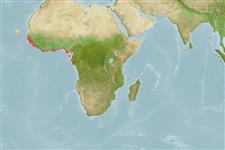Actinopterygii (ray-finned fishes) >
Perciformes (Perch-likes) >
Lethrinidae (Emperors or scavengers) > Lethrininae
Etymology: Lethrinus: Greek, lethrinia, a fish pertaining to genus Pagellus. More on author: Valenciennes.
Environment / Climate / Range
Ecology
Marine; reef-associated; non-migratory; depth range 1 - 50 m (Ref. 2683). Tropical, preferred 27°C (Ref. 107945); 20°N - 5°S
Eastern Central Atlantic: Senegal to Gabon; also Cape Verde, São Tome-Principe Islands, and Rolas Islands. There is little doubt that only a single species of Lethrinus exists in the tropical western Atlantic.
Length at first maturity / Size / Weight / Age
Maturity: Lm 22.8, range 21 - ? cm
Max length : 50.0 cm TL male/unsexed; (Ref. 2295); common length : 30.0 cm TL male/unsexed; (Ref. 2295)
Dorsal
spines
(total): 10;
Dorsal
soft rays
(total): 9;
Anal
spines: 3;
Anal
soft rays: 8. The outer surface of the maxilla is smooth, without a knob or pronounced longitudinal ridge. Inner surface of the pectoral fin axil without scales. Overall color is olive green or brown and pinkish. The cheeks have a network of fine reticulations below the eye.
Found in shallow coastal waters (Ref. 2263). Feeds mainly on bottom-dwelling invertebrates. Marketed fresh (Ref. 171), smoked and dried salted (Ref. 2295). Abundant during the winter months (Ref. 2683).
Life cycle and mating behavior
Maturity | Reproduction | Spawning | Eggs | Fecundity | Larvae
Carpenter, K.E. and G.R. Allen, 1989. FAO Species Catalogue. Vol. 9. Emperor fishes and large-eye breams of the world (family Lethrinidae). An annotated and illustrated catalogue of lethrinid species known to date. FAO Fish. Synop. 125(9):118 p. Rome: FAO. (Ref. 2295)
IUCN Red List Status (Ref. 115185)
CITES (Ref. 94142)
Not Evaluated
Threat to humans
Harmless
Human uses
Fisheries: commercial
More information
ReferencesAquacultureAquaculture profileStrainsGeneticsAllele frequenciesHeritabilityDiseasesProcessingMass conversion
Tools
Special reports
Download XML
Internet sources
